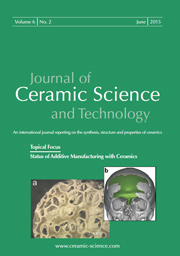Articles
All articles | Recent articles
Electrochemically Induced Degradation of Screen-Printed Gold Thick Films
T.J. Rabbow1, N. Junker2, C. Kretzschmar1, M. Schneider1, A. Michaelis1
1 Fraunhofer Institut für keramische Technologien und Systeme/Fraunhofer Institute for Ceramic Technologies and Systems, Winterbergstrasse 28, 01277 Dresden, Germany
2 Institut für Werkstoffwissenschaft/Institute of Materials Science, TU Dresden, Helmholtzstrasse 7, 01069 Dresden, Germany
received June 20, 2012, received in revised form August 28, 2012, accepted October 2, 2012
Vol. 3, No. 4, Pages 199-210 DOI: 10.4416/JCST2012-00023
Abstract
Gold thick films have been characterized by means of cyclic voltammetry in nitric acid and are compared with a pure gold electrode. Surface reconstruction and roughening is found for all electrodes, whereby the pure gold reference sample rapidly exhibits stationary behavior. In contrast, the screen-printed electrodes show a permanent linear increase of the gold surface area as measured by the charge densities for gold oxidation, which is connected with the dissolution of glass-ceramic compounds. Oxides of bismuth and copper and their aluminates are regularly used to adjust the morphology of thick films and to enhance the adhesion of screen-printed layers. Electrochemical reactions of both elements (Bi, Cu) are detected. An in-house produced gold paste free of these oxides was used for comparison and shows a linear increase in oxidation charge density as well. Cu and Bi compounds take part in the electrochemical reaction and accelerate the surface increase. The dissolution of glass-ceramic components from the surface and at the interface between thick film and substrate is revealed in FESEM images of the electrodes and at cross-sections. A model is set up for the electrochemically induced localized degradation of the thick films, which are attacked at the boundary layer to the electrolyte and the glass-ceramic interface between the LTCC substrate and gold layers.
![]() Download Full Article (PDF)
Download Full Article (PDF)
Keywords
LTCC, screen printing gold paste, thick film electrode, electrochemical degradation
References
1 M̩nil, F., Deb̩da, H., Lucat, C.: Screen-printed thick-films: from materials to functional devices, J. Eur. Ceram. Soc., 25, 2105 Р2113, (2005).
2 2. Pysch, D., Mette, A., Filipovic, A., Glunz, S.W.: Comprehensive analysis of advanced solar cell contacts consisting of printed fine-line seed layers thickened by silver plating, Prog. Photovoltaics: Research and Applications, 17, 101, (2009).
3 Park, C.O., Akbar, S.A.: Ceramics for Chemical Sensing, , 38, 4611 – 4637, (2003).
4 Goldbach, M., Axthelm, H., Keusgen, M.: LTCC-based microchips for the electrochemical detection of phenolic compounds, Sensor Actuat. B-Chem., 120, 346, (2006).
5 Johannessen, R., Oldervoll, F., Strisland, F.: High temperature reliability of aluminium wire-bonds to thin film, thick film and low temperature co-fired ceramic (LTCC) substrate metallization, Microelectron. Reliab., 48, 1711 – 1719, (2008).
6 Gongora-Rubio, M.R., Fontes, M.B.A., Mendes da Rocha, Z., Richter, E.M., Angnes, L.: LTCC manifold for heavy metal detection system in biomedical and environmental fluids, Sensor Actuat. B-Chem., 103, 468, (2004).
7 Rabbow, T.J., Junker, N., Schneider, M., Michaelis, A.: Screen-printed gold thick films for electrochemical sensor applications, Materialwiss. Werkst., 42, 777, (2011).
8 Mattox, D.M., Robinson, J.: Chemical durability of lead-oxide-based, thick-film binder glasses, J. Am. Ceram. Soc., 80, 1189 – 1192, (1997).
9 http://www.imaps.org/membership/CorpBulletin/archives/2007/2007sept4.htm
10 Imanaka, Y.: Multilayered low temperature cofired ceramics (LTCC) technology, Springer (2005).
11 Buchanan, R.C.: Ceramic materials for electronics, Marcel Dekker Inc., New York, 2nd Ed. (1991).
12 Fischer, L.M., Tenje, M., Heiskanen, A.R., Masuda, N., Castillo, J., Bentien, A., Ãmneus, J., Jakobsen, M.H., Boisen, A.: Gold cleaning methods for electrochemical detection applications, Microelec. Eng., 86, 1282 – 1285, (2009).
13 Gao, X., Edens, G.J., Hamelin, A., Weaver, M.J.: Real-space formation and dissipation mechanisms of hexagonal reconstruction on Au(100) in aqueous media as explored by potentiodynamic scanning tunneling microscopy, Surf. Sci., 296, 333, (1993).
14 Hamelin, A.: Behaviour of au (100) in perchloric and sulphuric acid solutions, J. Electroanal. Chem., 255, 281, (1988).
15 Silva, F., Sottomayor, M.J., Martins, A.: Study of electrochemical properties of Au(210) face electrode in nitrate solutions, Electrochim. Acta, 39, 491, (1994).
16 Shackleford, S.G.D., Boxalla, C., Porta, S.N., Taylor, R.J.: An In Situ electrochemical quartz crystal microbalance study of polycrystalline gold electrodes in nitric acid solution, J. Electroanal. Chem., 109, 538 – 539, (2002).
17 Peuckert, M., Coenen, F.P., Bonzel, H.P.: On the surface oxidation of a gold electrode in 1 N H2SO4 electrolyte, Surf. Sci., 141, 515, (1984).
18 Kadota, S., Shibata, K.: Gold conductor pastes for high density circuit, Electrocomp. Sci. Tech., 9, 31 – 41, (1981).
19 Ishiguro, T., Kitazawa, A., Mizutani, N., Kato, M.: Single-crystal growth and crystal structure refinement of CuAlO2, J. Solid State Chem., 40, 170, (1981).
20 Paulsson, H., Rosén, E.: A study of the formation of CuAl2O4 from CuO and Al2O3 by solid state reaction at 1000 °C and 950 °C, Z. Anorg. Allg. Chem., 401, 172, (1973).
21 MacKenzie, K.J.D., Dougherty, T., Barrel, J.: The electronic properties of complex oxides of bismuth with the mullite structure, J. Eur. Ceram. Soc., 28, 499 – 504, (2008).
22 Bloom, I., Hash, M.C., Zebrowski, J.P., Myles, K.M., Krumpel, M.: Oxide-ion conductivity of bismuth aluminates, Solid State Ionics, 53 – 56, 739 – 747, (1992).
23 Lide, D.R.: CRC Handbook of chemistry and physics, CRC Press, Boca Raton, 73rd edition, (1992).
24 Trasatti, S., Petrii, O. A.: Real surface area measurements in electrochemistry, Pure Appl. Chem., 63, 711, (1991).
25 Laitinen, H.A., Chao, M.S.: The anodic surface oxidation of gold, J. Electrochem. Soc., 108, 726, (1961).
26 Brummer, S.B., Makrides, A.C.: Surface oxidation of gold electrodes, J. Electrochem. Soc., 111, 1122, (1964).
27 Dickinson, T., Povey, A.F., Sherwood, P.M.A.: X-ray photoelectron spectroscopic studies of oxide films on platinum and gold electrodes, J. Chem. Soc. Faraday T., 71, 298, (1975).
28 Angerstein-Kozlowska, H., Conway, B.E., Hamelin, A., Stoicoviciu, L.: Elementary steps of electrochemical oxidation of single-crystal planes of au - I. chemical basis of processes involving geometry of anions and the electrode surfaces, Electrochim. Acta, 31, 1051 – 1061, (1986).
29 xcScaron;trbac, S., Adžić, R.R., Hamelin, A.: Oxide formation on gold single crystal stepped surfaces, J. Electroanal. Chem., 249, 291, (1988).
30 Cahan, B.D., Villullas, H.M., Yeager, E.B.: The effects of trace anions on the voltammetry of single crystal gold surfaces, , 306, 213, (1991).
31 Hamelin, A.: Cyclic voltammetry at gold single-crystal Surfaces. part 1. behaviour at low-index faces, J. Electroanal. Chem., 407, 1, (1996).
32 Juodkazis, K., Juodkazyt, J., Šebeka, B., Lukinskas, A.: Cyclic voltammetric studies on the reduction of a gold oxide surface layer, Electrochem. Comm., 1, 315, (1999).
Copyright
Göller Verlag GmbH


